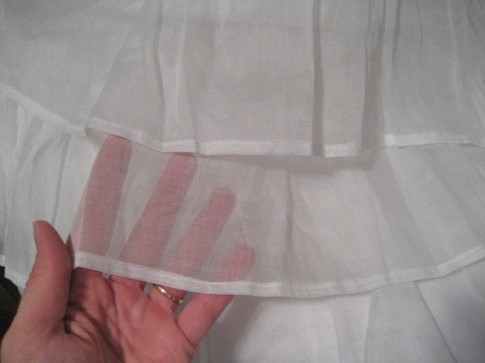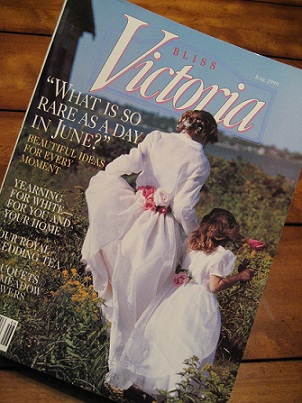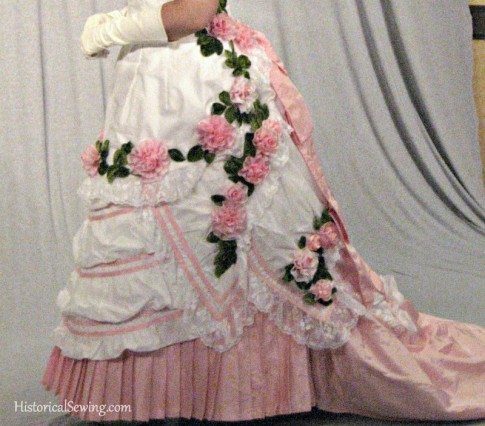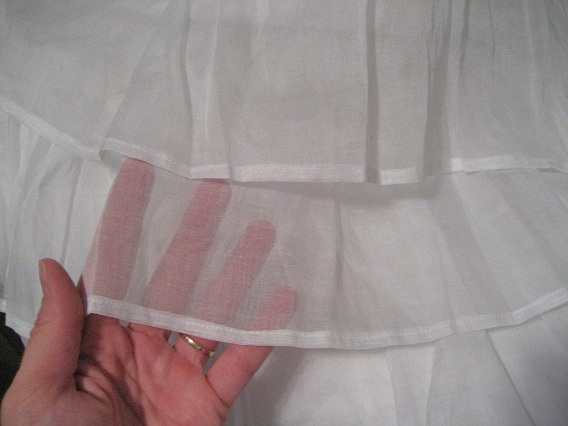
It was a distinct turning point in my historical costuming. I thought I was doing pretty good – my costumes were fairly accurate in style, my undergarments were all present, and my fabric selections did not include polyester or nylon. I soaked up all I could on how to make my Victorian clothing better.
What I didn’t expect was my introduction to a “standard” cotton textile that would ROCK my sewing world.
My friends… meet the Costumer’s Dream Fabric: Organdy.
The Backstory:
My long-time friend, lana/Lily, and I were researching corded petticoats and how starching is so important for an accurate 19th C. look.
Somehow she had recently thought of/found/researched and generally came up on cotton organdy. It was then we ran ahead in our minds and discovered all the glorious uses of this “basic” fabric.
The History:
Organdy is a plain-weave textile generally woven from cotton. It is then treated up to three different ways for either a permanent or semi-permanent finish. This finish is what gives it its stiffness. It’s a similar treatment as starching, and my guess is that today’s organdies are chemical finished.
In my mind, organdy was this unknown fabric that was only used in “old-fashioned” clothing (love that description) and not available anymore. (Have you thought that when hearing the word organdy?)
I still have a Victoria magazine from many, many years ago showing a woman in an organdy dress running through a tall grassy field and a little girl at her side. Her dress was a pure white organdy.

How could you make dresses from organdy? It was somehow embedded in my mind that organdy was stiff. A dress drapes. Organdy doesn’t. Well, that’s before I found out it comes in varying finishes: stiff and soft. (There is a medium finish available but not as quickly found in the marketplace).
The Difference:
Just to clear things up – organDY is made from cotton. OrganZA is traditionally silk but generally in polyester or nylon nowadays. (Avoid this stuff if you don’t want to swear out a storm.)
But you know what makes this the Dream Fabric?
- The weight is very light (HUGE feature)
- The ability to hold other fabrics together (like a base under trim or unusual fabric shapes)
- Holds its own shape (bias stretching is minimal)
- Being made of cotton
- The no need for starch
What You Can Make:
Being naturally stiff, use it for petticoats. 78% of them. Really. Especially the ruffles. You will ask yourself what took you so long to use this fabric.
Corded petticoats are beautiful and light-weight when made from organdy. (You don’t need a heavy fabric – the cords are weighty on their own and the stiff organdy will hold them in just fine.)
The thing about organdy is that it’s already starched so there’s a natural support built in. And it’s super lightweight to begin with (as if I haven’t mentioned it already). It’s a common modern misconception that you have to use a heavy fabric for petticoats. Why do that? Lightweight undergarments rock!

Use as an underlining for bodices and hem facings in skirts, or even fully flatlining a skirt. Collars & cuffs are natural uses. Belts, too, as an interlining.

Try it as a base for manipulated fabrics and applied trims like flowers and ribbons. Both aprons on my 1876 Wedding Cake Dress (above photo) and the 1873 Blackberry Cream Dress utilized organdy under the ruched fashion fabric to hold it in a defined shape.
Fast Sewing Tips:
-It can be slippery under your machine and you’ve got to control it. When you’re sewing a seam, the two edges can slip. Try a long hand baste stitch if you’re fighting with the organdy.
-Pins can slip out easily so pin accordingly.
-It wrinkles. Press as you would any cotton with a hot iron and steam. You may notice as you press the organdy gets soft. Not to worry – it stiffens as it cools.
-Press out all the creases before cutting your pieces. Use a rotary cutter and ruler for more precise cutting.
-Use a smaller needle like 70/10 to avoid large holes.
-Regular cotton/poly or poly thread works just fine.
-Keep to the grainline as you would on any other woven fabric.
Where to Buy Online:
Alas, I haven’t had good luck with finding organdy at the chains like JoAnn’s and Hobby Lobby. The large superstores might carry it for apparel but most of what you’ll find is in the home dec department. It’ll be called “organdy” but be 100% polyester or nylon. AVOID these!
You might also look in the interfacing section. (I know, weird, but it CAN be a great sew-in interfacing, not to be confused with crinoline.)
Pure Silks – A great place online for cotton organdy in both soft and stiff finishes. They are also on eBay as Exclusive Silks. Shipped from India it can take at least two weeks to receive in the US so plan ahead and order 10 yards at a time.
Needle & Thread (as Wooded Hamlet) – I’ve ordered many yards from here and being in the US can get to me quick. You’ll have to call to order & have it shipped. Be sure to ask how stiff their stock is as it varies. I’ve received both finishes from here.
Vogue Fabrics – One choice on the website: stiff, but it’s high quality.
Renaissance Fabrics – Diana has carried organdy in both 45″ and 60″ widths in the past. Inquire about stiffness and yardage in the inventory.
Farmhouse Fabrics – They have various organdies including COLORS. And if you want to go there, a quite expensive imported Swiss organdy – perfect for a little girl’s dress, not so much for a 10 yard-fabric bustle gown.
I encourage you to give organdy a try. You will love it!
Listen to my podcast episode 003 on organdy.
Have you used organdy before? Leave a comment below on what project you used it for.


You are so right! I have a small amount of cotton organdy from an old curtain, and it is perfect as a lining fabric-lightweight, spring-y and resistant to wrinkles but would take creases, firm enough to give body to lightweight top fabrics. I hadn’t thought of using it for petticoats-but I only had a few feet. Sadly, I am down to my last few square inches but I hadn’t found any to replace it. Thank you for the sources!
I have never sewn with Organdy, all I remember is wearing my favorite dress made of it to go to church on Sunday when I was about 10 years old. Here I am, almost 71, and I can still recall how I felt in that simply glorious fabic…heavenly.
I have a 1957 cotton organdy dress with a very full skirt and painted blue dots. That is what the expert at The Doll Cradle told me. I wore it to our rehearsal dinner. It is a beautiful dress and I would like to refresh it. The whiteness has discolored. I did put it in a heat free dryer for just a few minutes and that seemed to help a little. Do you have any suggestions? My next thought is to soak it in the bathtub and air dry it.
You could try bluing. You’ll find the little bottle in the laundry detergent aisle. It helps keep whites white and may lighten discolored whites.
44-45 width organdy seems to be easier to find. I’m planning on making a Victoria outfit. Must I find 60″ wide fabric? (I need to order the fabric now and I have not been able to study the patterns and layouts.)
Is fabric sold for home decor safe to make clothes?
Usually home dec fabrics are a bit stiffer (for better household wear) but you can still find good ones for apparel. Be sure your organdy is 100% cotton and not a blend or synthetic which is highly used in home dec fabric production.
Genius! I had wondered where to get cotton organdy for some years. My source dried up a few years ago, much to my dismay! Then, I stumble onto your site and voila! not only cotton organdy but SILKS!!! Puresilks simply blew me out of the water! Just placed a nearly $300 order which I now eagerly await! My next Steampunk creation will be a smash thanks to the information you provided on this resource! Thank you so very, very much!
Just finally got my first organdy stash (10 yards at $4.99/yard!) And I can’t WAIT to use it!!
Years ago, I made a 1840 afternoon dress in a light sage organdy. It was a dream to work with and the dress held up well. I only had to starch it lightly when I ironed. I just loved the crispness of the fabric.
What about using a spray sizing with cotton organdy?
Are you talking about starching organdy?
Love organdy! Scarlett’s white ruffled gown in Gone With the Wind was organdy. I believe it was tiers of bias cut layers, rather than gathered ruffles.
I have purchased nice organdy from the Amish before. It is fun to play with!
Wow that’s amazing. Just made one simple petticoat for my regency ball gown and it completely changed the silhouette.
Petticoats are amazing and are the basis for great historical silhouettes – which you have so wonderfully discovered. 🙂
I have had bad experiences with modern polyester ones with the plastic tulle in the past. Mainly itching and sweating and then there is the expense for said monstrosity.
In years past I was a square dancer. We wore very full petticoats and had a secret for keeping them stiff.
Here in the desert (Arizona) we don’t like to keep fabric with starch in it around for long because starch is made from corn and it attracts bugs. SO,we discovered that we could spray our clean petticoats with “Future” floor finish. It is an acrylic “wax” for floors, but it works wonders as a starch replacement.
Also, if we were careful, we could rinse soiled petticoats in cold water and the acrylic finish would stay. We didn’t have to re-coat for a couple of rinses.
The same should help the cotton organdy. I would check a sample to be sure, but don’t see a problem with using it.
BTW, we also checked flame sensitivity and the acrylic does not make the garment any more flammable than it was originally, and may actually help a bit.
Hope someone can use this info.
Pati, in Phoenix
A splendid article! Thank you. I am always on the lookout for improving quality but also authenticity. I have a few antiqe garments that I want to look at again – perhaps they have organdy and not another cotton in various places. Good to see that Diana at Renaissance Fabrics is carrying it too.
This was made by a friend of mine, for me – a couched and beaded Italian partlet, all on ivory cotton organdy. It looks like silk with its sheen, and the stiffness helps the partlet hold its shape despite the weight of all the beading. I LOVE it.
I ordered some cotton organdy from Vogue for a Truly Victorian petticoat pattern and it’s stiff. REALLY stiff. Like, “I don’t know if I can even gather this” stiff! But I’m worried that if I wash it it’ll be soft as muslin!
I love stiff cotton organdy and order it in Australia on 100m rolls. Happy to supply anyone here.
I have a plan for several petticoats, one of which will be a corded petticoat and this blog post is definitely timely. I have looked at several of the sites you mentioned for ordering organdy and I admit to being a bit lost. I am betting that the soft organdy isn’t the route to go so perhaps I am asking which stiffness would be the right one for petticoats?? A plain petticoat vs. a corded?? If I am ordering organdy (especially from another country) I would prefer not to make any errors on ordering the wrong kinds.
I’ve made corded petticoats from both stiff and soft but prefer stiff.
You’re right that the sites can be confusing. Most sellers only sell the soft finish organdy (and may not even know it comes in different finishes). Better ask before ordering if it stand up on its own (stiff) or if it falls a bit when standing (soft).
The stiff is the best for plain petticoats and ruffles. You can use the soft but may need an additional petticoat and/or more ruffles – more rows or more densely gathered.
If you end up with soft, you can always use it for collars, undersleeves and underlinings.
Have you checked out Dharma Trading’s website. They have a wonderful selection of all natural fabrics, most in white or natural. Some black but not much. Their service is wonderful
When my grandmother died my mother gave me most of the material that was in my grandmothers cupboards. As my grandmother was a seamstress as well as a passionate quilt maker, there is a lot of material left. I was lucky to be given a complete bolt as well as a half of a bolt of stiff organdy. I have not used much of it as I have only mad a blouse and a half slip. BUT, I do love the stiffness that the organdy gives to the slip and the the blouse. I just wish that it was available locally so that I do not have to pay shipping costs to replace it when I have used it up. Thank you for discussing this material as it is very useful for so many projects in sewing, crafting, etc.
I love using organdy myself. It makes perfect 18th century ladies caps and is closer to originals than anything else. I got this first hand 34 years ago from an old woman who remembered her grandma’s cap very well. I have made several coifs from old organdy aprons which may even have some beautiful needlework on them to take advantage of!
My request here is that you list the websites or phone numbers or addresses for your sources…
Let me also tell you that I am very glad you have kept up this historical sewing information.
Caroline – You’ll notice the underlined names in the post of the online sources I recommend. They are live links, so clicking on the name will take you to the website where you can then search for organdy.
Oh Thank you so much! Love this posting. Myself and a friend have been trying to find organdy up at the LA textile mart, but to no avail. Your “where to buy” information is very much appreciated!
I use organdy a lot for making late 18th century bonnets, you know those large poufy ” Martha Washington type of head gear. and I too have had issues with finding sources for it ( thanks for the LIst!) and keeping its stiffness up to snuff. A liberal use of spray starch will help some I have actually made starch to use for this. but again finding resources is not easy . As you mentioned , basting is almost a necessity, but eventually you can get the “feel” of the fabric and how easy it is to use.
I bought some 100% cotton organdy in the garment district recently but it must be the softer hand you spoke of. I really like it but it definitely will need some starching. Thank you for the great hint.
Yes, there are some organdies out there that the finish will fade with washing. Not knowing textile production I don’t know how to tell. You could ask the retailer but even then they may not know for sure.
I think over time with repeated washings, all organdies will lose some of their stiffness. It probably won’t fade to a voile softness though. Then there’s always dip starching. 🙂
Have you had issues with the stiffness disappearing from organdy when you wash it? I’ve noticed that some types of organdy will withstand washing and still be crisp, and some won’t, and it’s hard to tell which is which. And honestly, doing living history in the Georgia heat, I’m going to have to wash petticoats and such. Any suggestions?